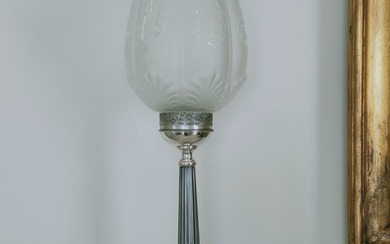A FINE ENAMELED WHITE GLASS 'MAGNOLIA & PEONY' SNUFF BOTTLE, REPUBLIC PERIOD
A FINE ENAMELED WHITE GLASS 'MAGNOLIA & PEONY' SNUFF BOTTLE, REPUBLIC PERIOD
China, 1912-1949 or slightly later. The flattened spherical body supported on a short oval foot and rising to a cylindrical neck. Finely enameled to one side with gnarled branches of flowering magnolia growing amongst coral-colored peony blossoms, and to the other with a two birds of paradise perched on crabapple, all below pendent ruyi heads encircling the shoulder below a band of leafy scroll. The base inscribed with the blue-enameled three-character hall mark.
Inscriptions: To the base, 'Guyue Xuan'.
Provenance: From the Dorf private collection. In 1975, Ted Dorf received a cinnabar snuff bottle from a family member, sparking a lifelong interest for collecting these portable treasures. The Dorfs were also active in the International Chinese Snuff Bottle Society and enjoyed collecting other forms of Chinese art as well, in addition traveling the globe and visiting museums. The Dorfs met at Temple University, and both held long careers in radio and broadcasting, serving on numerous company boards, truly sharing all aspects of their life with great passion. A collector's number to the side '132'.
Condition: Very good condition with minor wear, minuscule nibbling to the mouth and foot, and light surface scratches.
Stopper: Agate, carved spoon
Weight: 63.9 g
Dimensions: Height including stopper 63 mm, Diameter neck 18 mm and mouth 7 mm
Guyue Xuan is the name of one of the halls within the Changchun Yuan (a series of Imperial gardens to the West of Beijing adjoining the Yuanming Yuan, known collectively as the Summer Palace). The Changchun Yuan was intended as a retirement home for the Qianlong Emperor, although he never took up full-time residence there. The Guyue Xuan was completed in 1767 and was later used as a studio for enameled works on glass. These Guyue Xuan wares were initially designed as awards for distribution during the annual Imperial hunts conducted north of the Great Wall.
The flowers on this snuff bottle evoke an auspicious rebus, or multipart visual pun: magnolia (yulan), crabapple (haitang), and peony (nicknamed fugui) combine to mean 'fortune in the jade hall' (yutang fugui), a wish for riches and honor, and a fitting symbol for an official gift or prize.
Sale price
Estimate
Time, Location
Auction House
A FINE ENAMELED WHITE GLASS 'MAGNOLIA & PEONY' SNUFF BOTTLE, REPUBLIC PERIOD
China, 1912-1949 or slightly later. The flattened spherical body supported on a short oval foot and rising to a cylindrical neck. Finely enameled to one side with gnarled branches of flowering magnolia growing amongst coral-colored peony blossoms, and to the other with a two birds of paradise perched on crabapple, all below pendent ruyi heads encircling the shoulder below a band of leafy scroll. The base inscribed with the blue-enameled three-character hall mark.
Inscriptions: To the base, 'Guyue Xuan'.
Provenance: From the Dorf private collection. In 1975, Ted Dorf received a cinnabar snuff bottle from a family member, sparking a lifelong interest for collecting these portable treasures. The Dorfs were also active in the International Chinese Snuff Bottle Society and enjoyed collecting other forms of Chinese art as well, in addition traveling the globe and visiting museums. The Dorfs met at Temple University, and both held long careers in radio and broadcasting, serving on numerous company boards, truly sharing all aspects of their life with great passion. A collector's number to the side '132'.
Condition: Very good condition with minor wear, minuscule nibbling to the mouth and foot, and light surface scratches.
Stopper: Agate, carved spoon
Weight: 63.9 g
Dimensions: Height including stopper 63 mm, Diameter neck 18 mm and mouth 7 mm
Guyue Xuan is the name of one of the halls within the Changchun Yuan (a series of Imperial gardens to the West of Beijing adjoining the Yuanming Yuan, known collectively as the Summer Palace). The Changchun Yuan was intended as a retirement home for the Qianlong Emperor, although he never took up full-time residence there. The Guyue Xuan was completed in 1767 and was later used as a studio for enameled works on glass. These Guyue Xuan wares were initially designed as awards for distribution during the annual Imperial hunts conducted north of the Great Wall.
The flowers on this snuff bottle evoke an auspicious rebus, or multipart visual pun: magnolia (yulan), crabapple (haitang), and peony (nicknamed fugui) combine to mean 'fortune in the jade hall' (yutang fugui), a wish for riches and honor, and a fitting symbol for an official gift or prize.




